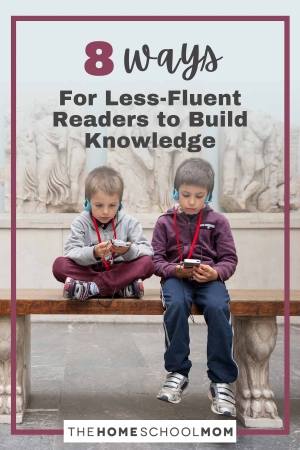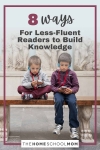In a recent post, I talked about how skill lags in reading and writing often create "content" lags for traditionally schooled students. Kids who go to school are under a lot of pressure to be early and proficient readers and writers, because academic work in other subjects becomes dependent on being able to read well and write well during the early grades.
However, I mentioned that this is less of a problem for homeschoolers, because homeschooling's flexibility means learning can continue during skill lags.

We can continue to help our kids build content during skills lags, customizing what works for each child. Experienced homeschoolers often fall into these techniques over time, but I offer a few of my favorite ways you can help your child get "subject area learning" before his reading and writing skills are developed to an extent that they can be the primary routes to learning.
1 - Listen to Audiobooks.
There are many ways that audiobooks can benefit your homeschooling. My children enjoyed audiobooks of all kinds as early as toddlerhood and all the way up to their high school years-even after their reading skills were excellent. During periods of skill lags (which may come and go unevenly), our use of fiction audiobooks kept the kids exposed to classic children's literature that was frequently above their reading level.
Our use of nonfiction audiobooks helped them learn about great inventors, great music, and great art. And perhaps most enjoyable for our family were historical fiction audiobooks, particularly those narrated by Jim Weiss.
2 - Do hands-on projects
Kids who can't read highly detailed volumes about, say, the solar system, can enjoy building models based on what a parent reads or tells them about each planet and the solar system in general. One of my kids built dioramas based on the Laura Ingalls Wilder Little House books, which I read aloud to him.
These types of projects actually work to build "comprehension," because the child takes action to construct the project based on what he is learning and understanding-even if at first, he is not reading all the words himself.
3 - Try notebooking
Kids who aren't adept readers and writers may nonetheless enjoy assembling a notebook about a subject they are studying. There are some outstanding notebooking resources for homeschoolers online, but I admit my kids mostly took a simpler approach.
When one of my children was interested in ice skating, he assembled a notebook with clippings about the history of skating, the physics of skating, the development of competitive skating, famous skaters, and skating techniques. While some of this strictly related to the modern sport of ice skating, he learned a surprising amount of general history, world geography, and world culture.
For example, he printed online articles for his notebook that included ice skating's place in the history of Scandinavia-something I'd have had a lot of trouble getting him to read about from a textbook, but which he absorbed over time as he read in brief snatches traveling to and from ice skating.
4 - Embrace passion-directed learning
When one of my children was not ready for intensive study of more typically "required" subjects through reading, I let him sidestep those subjects for a while. He was very interested in dogs. He wanted a dog, and I told him that if he researched how to select, care for, and train a dog, I would consider getting him a dog. This motivated him more than reading in areas that were less interesting to him from textbooks that were temporarily above his fluent reading level.
We checked out every dog book in the library, borrowed dog books from friends, and watched videos about dogs. I also arranged for him to volunteer at the animal shelter and learn about society's problem with pet overpopulation. He spent a lot of time talking to people about various breeds, dog behavior, and dog health.
Once we adopted a puppy, he attended two series of training classes, which furthered his understanding of responsible pet ownership and animal behavior. Somehow, again, he learned a lot of general history and geography through this passion-drive project, because he learned how different types of dogs were bred for different purposes in different parts of the world. Additionally, he was exposed to basic ideas of genetics as well as mammal physiology and anatomy.
He picked up an awful lot of general science and history during his "dog days," which, along with his other learning, meant that by the time he was excelling in reading and ready to cover "real" science, he'd learned a lot of elementary science that some of his schooled peers had missed. My experience led me write about how homeschoolers can easily do a unit study around pets.
5 - Read books aloud during playtime
My kids weren't always keeping busy doing content-based projects or notebooks. Sometimes they just wanted to play in the sandbox, build with craft sticks, play with Play dough, mess with their Matchbox cars, build with Legos, or paint or draw.
I spent many hours reading to them as they drove their trucks through the sand, building intricate roads and tunnels. I found their comprehension was especially high when they were engaged this way. Their busy boy hands were occupied and for some reason, their brains were open. I find moms have to keep an open mind during this time. Boys can look like they're not paying attention, but sometimes an awful lot of what you are reading does sink in.
Related to this, I frequently arranged for a younger sibling to be playing quietly nearby as I did read alouds and discussion of history and science with the older ones. While the younger sibling could not read at the same level, he picked up an amazing amount of material as we worked our way through the ten-volume set of A History of US by Joy Hakim (affiliate link). Additionally, he benefited from eavesdropping on the discussion, which gave him early exposure to synthesizing ideas.
6 - Watch films and videos
By now, everyone knows how much kids can learn from watching The History Channel and The Discovery Channel. With just a little bit of forethought, you can use great video to cover things that your kids might typically be ready to learn if they just didn't have to depend on later developing reading skills.
You'll find that your children can become conversant on black holes and nebulae-not just galaxies "far, far away"-if you encourage and allow them to build knowledge from the excellent documentaries available today.
You can pair watching movies with reading books aloud to cover even more ground.
7 - Try experiments
A kid who may not be ready to read about scientific concepts in the abstract can certainly learn them by doing them hands-on. A great resource is Supercharged Science (30 fun science activities with free registration), whose expansive library of experiments is sure to help your child build scientific understanding.
8 - Go on field trips
Visiting historic sites, museums, businesses, universities, caverns, state and national parks, wildlife areas, tidal pools, and other interesting places is a great way for kids to build an understanding of the world that they may not be able to get at their level of independent reading in the early years. The geology of stalactites and stalagmites might remain buried in an earth science text, but they are easy to identify when you see them in a cavern like Shenandoah Caverns in Virginia or Mystic Caverns in Arkansas.
Virtual field trips are a good alternative when physically visiting a destination isn't possible.
Put it all together
Homeschoolers do a lot of these kinds of activities because other homeschoolers are doing them, and they like the refreshing change that comes with varying activities. They also know that by using differing approaches, they have a good chance of meeting various learning styles their children may have.
But it's also true that these activities help build content, and having children build knowledge is key to helping them build an understanding of the world.
As homeschoolers, we have the flexibility to use these approaches, and others like them, to help our children learn, even if the kids are not at a stage of being able to read well enough to "learn it from a book." I've found myself in many conversations with homeschooled kids who are later readers or later developing fluency, and I'm frequently amazed at the knowledge they've amassed.
How have you helped your kids build knowledge during a skill lag?




 A popular speaker at homeschooling conferences, business groups, and parents’ groups, Jeanne Potts Faulconer homeschooled her three sons in North Carolina, Mississippi, and Virginia for twenty years. Holding her Master of Arts degree in Communication, Jeanne conducted portfolio evaluations for Virginia homeschoolers for evidence of progress for many years. Jeanne is a former college faculty member, former editor for several publications, news correspondent for WCVE, and former director of Brave Learner Home. She is the contributing editor for TheHomeSchoolMom newsletter and writes the popular Ask Jeanne column addressing homeschool parents' questions here at TheHomeSchoolMom.
A popular speaker at homeschooling conferences, business groups, and parents’ groups, Jeanne Potts Faulconer homeschooled her three sons in North Carolina, Mississippi, and Virginia for twenty years. Holding her Master of Arts degree in Communication, Jeanne conducted portfolio evaluations for Virginia homeschoolers for evidence of progress for many years. Jeanne is a former college faculty member, former editor for several publications, news correspondent for WCVE, and former director of Brave Learner Home. She is the contributing editor for TheHomeSchoolMom newsletter and writes the popular Ask Jeanne column addressing homeschool parents' questions here at TheHomeSchoolMom.
Thank you so much for the suggestions and articles on so many homeschool related topics. I have found great encouragement and the needed resources to improve my approach with my little individual.